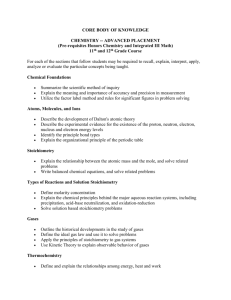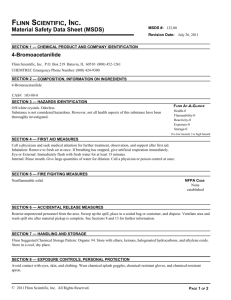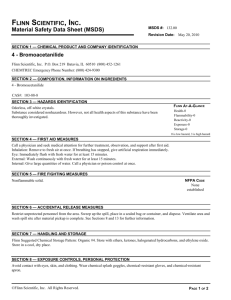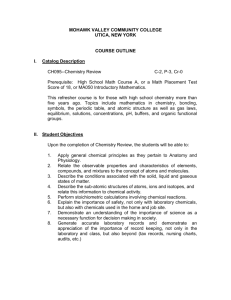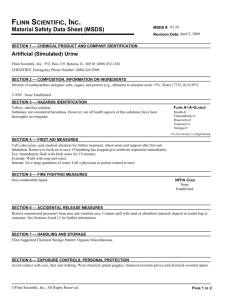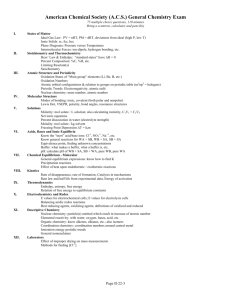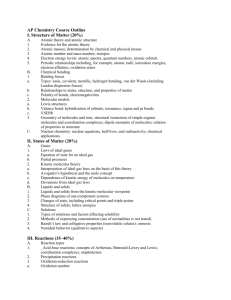IX. Nuclear Chemistry
advertisement
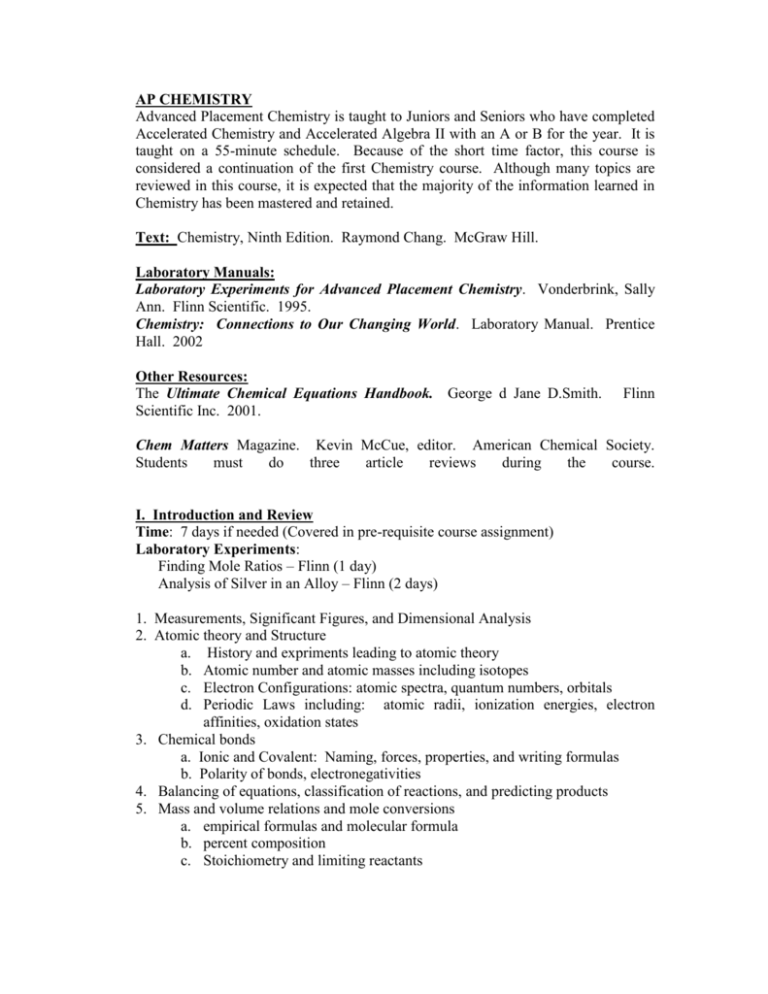
AP CHEMISTRY Advanced Placement Chemistry is taught to Juniors and Seniors who have completed Accelerated Chemistry and Accelerated Algebra II with an A or B for the year. It is taught on a 55-minute schedule. Because of the short time factor, this course is considered a continuation of the first Chemistry course. Although many topics are reviewed in this course, it is expected that the majority of the information learned in Chemistry has been mastered and retained. Text: Chemistry, Ninth Edition. Raymond Chang. McGraw Hill. Laboratory Manuals: Laboratory Experiments for Advanced Placement Chemistry. Vonderbrink, Sally Ann. Flinn Scientific. 1995. Chemistry: Connections to Our Changing World. Laboratory Manual. Prentice Hall. 2002 Other Resources: The Ultimate Chemical Equations Handbook. George d Jane D.Smith. Scientific Inc. 2001. Flinn Chem Matters Magazine. Kevin McCue, editor. American Chemical Society. Students must do three article reviews during the course. I. Introduction and Review Time: 7 days if needed (Covered in pre-requisite course assignment) Laboratory Experiments: Finding Mole Ratios – Flinn (1 day) Analysis of Silver in an Alloy – Flinn (2 days) 1. Measurements, Significant Figures, and Dimensional Analysis 2. Atomic theory and Structure a. History and expriments leading to atomic theory b. Atomic number and atomic masses including isotopes c. Electron Configurations: atomic spectra, quantum numbers, orbitals d. Periodic Laws including: atomic radii, ionization energies, electron affinities, oxidation states 3. Chemical bonds a. Ionic and Covalent: Naming, forces, properties, and writing formulas b. Polarity of bonds, electronegativities 4. Balancing of equations, classification of reactions, and predicting products 5. Mass and volume relations and mole conversions a. empirical formulas and molecular formula b. percent composition c. Stoichiometry and limiting reactants II. Solutions Time: 8 days Laboratory Experiments: Titration to determine concentration of an unknown acid Freezing Point Depression of Antifreeze – Prentice Hall 1. Types and components of solutions and factors affecting solubility Including aqueous solutions, gases, and alloys 2. Concentrations: Molality, Molarity, ppb, ppm 3. Reactions in Aqueous Solutions a. precipitation reactions 1. electrolytes and non electrolytes 2. solubility rules 3. net ionic equations b. neutralization reactions 1. strong acids and bases in relation to solubility c. redox reactions 1. oxidation numbers 2. activity series 4. Boiling Point elevation, freezing point depression, lowering vapor pressure(Raoults law), Osmosis 5. Colloids characteristics and separation by physical means 6. non-ideal behavior (qualitative aspects) 7. Other integrating topics: enthalpy, intermolecular attractions Calculations: Molarity and Molality Titrations Henry’s Law Boiling point elevation Freezing point depression Osmosis Vapor pressure – Raoults law Molar Mass by experimental means III. Kinetics Time: 10 days Laboratory Experiments: Concentration and Reaction Order – Prentice Hall (1.5 days) Iodine Clock Reaction – Study of the Kinetics of a Reaction – Flinn (1 day) 1. Use of experimental data and graphical analysis to determine reactant order, rate constants, and reaction rate laws 2. Integrated Rate laws for first and second order reactions, and half life calculations. 3. Effect of temperature change on rates 4. Collision Theory and the energy of activation; the role of catalysts 5. Reaction mechanisms and rate-determining steps Calculations: Rate Stoichiometry Reactant Order Initial Rate Laws Integrated Rate Law Half Life Calculations Activation Energy IV. Equilibrium Time: 14 days Laboratory Experiments: Determination of the Equilibrium Constant for the Formation of FeSCN +2 – Flinn (1.5 days) Equilibrium and LeChatliers Principle – Prentice Hall (1 day) Determination of the Equivalent Mass and the pKa of an Unknown Acid – Flinn (2 days @ 45 minutes) Determination of the Solubility Product of an Ionic Compound – Flinn (45 minutes) 1. Dynamic equilibrium and equilibrium constants 2. Equilibrium constants and direction of reaction 3. Equilibrium in relation to reaction mechanisms and predicting direction of reactions 4. Equilibrium Concentrations 5. LeChatliers Principle 6. Conjugate Acids and Bases: Common ion effect; buffers; hydrolysis 7. Solubility equilibrium and product constants in relation to precipitates and the slightly soluble compounds Calculations: Law of Mass Action Gas Equilibrium Initial and change equilibrium equations including application to quadratic equation Acid Base Equilibria Ka, Kb, Kw Solubility Constant (Ksp) V. Atomic Theories and Bonding Time: 12 days Laboratory Experiments: Modeling Covalent and Organic Compounds – Prentice Hall (45 minutes) Activity Series – Flinn (45 minutes) Preparation of Esters – Flinn (1 day) Vapor Pressure and Enthalpy of Vaporization of Water – Flinn (45 minutes) 1. Electron Theories: Heisenberg Uncertainty Principle, Hunds Rule, Pauli Exclusion. 2. Diamagnetic and paramagnetic 3. Bonding and bond energy 4. Structures a. Lewis Structures b. Polarity of bonds, electronegativities c. VSEPR and molecular geometry d. Resonance, Hybridization, and e. Organic naming and structures f. Exceptions to Octet Rule 5. Kinetic Molecular Theory and states of Matter 6. Intermolecular and Intramolecular forces a. including dipole, van der Waals, London Dispersion Forces, and Hydrogen bonds. b. Phase Changes c. Clausius Clapeyron d. Critical Temperature and Pressure e. Triple Point of phase diagrams Calculations: Clausius Clapeyron VI. Gas Laws Time: 8 days Laboratory Experiments: Molecular Mass of a Volatile Liquid – Flinn (1.5 days) Ideal Gas Constant – Prentice Hall (1 day) 1. Properties and relation to pressure 2. Gas Laws a. Boyles Law b. Charles Law c. Avogadros Law d. Ideal Gas Equation 3. STP Conditions 4. Gas Density 5. Partial Pressures 6. Kinetic Molecular Theory: movement, behavior, and application of theory. 7. Effusion 8. non-ideal behavior (qualitative aspects) Calculations: Boyles, Charles, Avogadros Law Ideal Gas Law Density of Gas Partial Pressures Effusion of Gas VII. Thermochemistry Time: 10 days Laboratory Experiments: Hess’s Law – Flinn (1 hour) Heat Capacity – Prentice Hall (1 hour) 1. Endothermic and Exothermic properties 2. State functions 3. First law: change in enthalpy; heat of formation; heat of reaction; Hess's law; heats of vaporization and fusion; calorimetry 4. Second law: entropy; free energy of formation; free energy of reaction; dependence of change in free energy on enthalpy and entropy changes 5.Relationship of change in free energy to equilibrium constants and electrode potentials Calculations: Heat Calculations (q and calories) Hess’s Law Enthalpy, Entropy, Gibbs Free Energy VIII. Electrochemistry Time: 9 days Laboratory Experiments: Electrochemical Cells – Flinn (1 day) Electrolysis of Water – Prentice Hall (1 hour) 1. Electrochemical Cells (Cathode and Anode) a. electrolytic and galvanic cells 2. Electrode Potentials and half reactions a. Oxidation-reduction reactions b. the role of the electron in oxidation-reduction 3. Faraday's laws 4. Nernst equation 5. prediction of the direction of redox reactions Calculations: Electrode Potentials Nernst equation IX. Nuclear Chemistry Time: 5 days Laboratory Experiments: Radioactive Decay Series – online alternative approach Law of Radioactive Decay – online alternative approach http://www.walter-fendt.de/ph14e/ 1. Radioactivity a. Alpha particle b. Beta Particles 2. Half Lives 3. Chemical Applications and uses.
